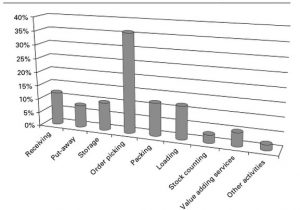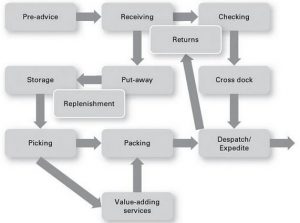Various warehouse processes are discussed in this section.
Improvement comes from simplifying processes and procedures. In order to improve efficiency and reduce cost within the warehouse operation it very important to get all warehouse processes to be aligned. Although warehouses differ in terms of size, type, function, ownership and location yet the fundamental processes remain the same and are critical to study for each manager. These processes include pre-receipt, receiving, put-away, storage, picking, replenishment, value-adding services and dispatch. Ensuring that the correct processes are in place and operating optimally, companies not only improves accuracy and efficiency but also take advantage of the new technology available.
Figure 3.1 below shows each warehouse activity as a percentage of cost, emphasizing the importance of the pick, pack and dispatch operation. The figure may vary significantly depending on the type of operation.
Figure: Warehouse activities as a percentage of total cost
E.g. companies which are under pressure to speed up throughput are likely to use concepts such as cross docking, thus reducing the amount of time spent on put-away, picking and retrieval.
Receiving goods-in or in-handling is a crucial process within the warehouse. Ensuring that the correct product has been received in the right quantity and in the right condition at the right time is one of the mainstays of the warehouse operation. These elements are often termed as supplier compliance.
Figure: Warehouse Processes
The receipt of goods into a warehouse needs to be a carefully planned activity. In most large warehouses, incoming vehicle loads are booked in advance so that the appropriate resources can be allocated to the activity. On arrival, drivers report to the gatehouse, where staff check the vehicle documentation and direct the driver where to go, either directly to an unloading bay or to a parking area.
A key objective in designing the receiving process is to enable the goods to be put away to the required location in the warehouse with the minimum handling and minimum delay possible. This often requires close co-ordination with suppliers, in terms of procurement agreements and the timing of deliveries.
At first it should be ensured that the supplier presents the products to the warehouse in most appropriate way. Generally, the buyer specifies the product and may not have knowledge of the goods-receiving operation. The warehouse manager is also involved in specifying and agreeing the packaging, items per carton, cartons per pallet and any specific labeling required, together with the mode of transport to ensure that the products ordered are compatible with the storage facility as it has been seen too often – items arriving at warehouses in unsuitable packaging that overhang pallets, has incorrect labels and with the goods and are packed in quantities that do not relate to selling-pack quantities.
All these problems take time to resolve and are better handled at the supplier prior to delivery. Areas that need to be discussed both internally and externally prior to the order being placed should include,
- size and type of cartons
- type of transit packaging – cardboard, plastic, totes, metal stillages, roll cages, pallets
- palletized or non-palletized delivery of product
- size (length, width and height) and type of pallets
- specific labeling such as product description, barcode and quantities
- carton quantities (inner and outer carton quantities)
- mode of transport, delivery quantity and frequency of delivery
Delivery in the normal selling quantity is also crucial in assisting the manager to increase the speed of throughput and simplify picking. The method of delivery needs to be compatible with the equipment available at the warehouse. The lack of loading bays, e.g. will necessitate the use of tail-lift-equipped or side-(un)loading vehicles. The transfer of much production offshore has resulted in a significant increase in container traffic. The decision here is to lose load or palletize the cargo.
The benefits of palletizing product include protection from loss or damage during handling and transportation and a reduction in the number of people required to load and unload containers. The process of loading and unloading is speeded up whilst space at the loading and dispatch bays is also reduced.
Utilizing off-the-shelf can potentially further improve the load building capability where the carton dimensions are not so straightforward both on a pallet and within a trailer or container. Currently there is no universally accepted standard for pallet dimensions. Different market sectors and organizations utilize many different pallet sizes around the globe. The International Organization for Standardization (ISO) sanctions six pallet dimensions, detailed in ISO Standard 6780.
Another truism to bear in mind is the 80/20 rule as it applies to suppliers. Not only is it likely that 20 per cent of your suppliers provide 80 per cent of your stock but it is likely that 20 per cent of your suppliers cause 80 per cent of your goods-in problems. You need to put measures in place to identify the suppliers who are not performing to standard and work with them to introduce improvements.
One of the main challenges for a warehouse manager is to match labor hours with work content. Handling a product in the least amount of time possible leads to reduced labor hours and, as a consequence, reduced cost. Depending on the operation, labor can be the single biggest cost within a warehouse. It can be between 48 and 60 per cent of the total warehouse cost depending on the amount of automation utilized. It is also the most difficult cost to control. In-handling makes up approximately 20 per cent of the total direct labor cost within a retail warehouse.
Prior to the actual receipt a number of processes need to take place. The first step is to ensure that suppliers deliver into the warehouse when you decide. By providing delivery times for each supplier or their subcontractors, one is in control and able to match the work hours to work content for which a booking-in system needs to be introduced.
It is therefore important to keep records of the time it takes for each type of delivery and share the information with the booking-in team. This will provide the amount of labour and equipment required to undertake the task, thus making planning a great deal easier. Warehouse staff needs to be aware of the products being delivered, the type of vehicle and the equipment required to offload.
On arrival, the vehicle details need to be checked against the booking reference and the vehicle allocated a loading bay or location in the yard. Any vehicle seals need to be checked against the delivery paperwork. Prior to offloading temperature-controlled vehicles, the temperature history of the vehicle whilst in transit needs to be checked, together with the current temperature of the goods. Once the vehicle has backed onto the appropriate bay or has been positioned in the yard for offloading from the sides, the in-handling team should have appropriate labour and equipment to handle the offloading process efficiently. When vehicles are unloaded in the yard this usually necessitates the use of two lift trucks, one to unload the trailer and another to put the product away within the warehouse.
In order to speed up this process, equipment companies have introduced an automatic unloading system, which means that a 26-pallet trailer can be unloaded within five minutes of arriving at the dock. Unloading methods include the use of rollers, tracks and slip chains whilst others use loading plates or giant slip sheets. Combine these with conveyors or automated guided vehicles (AGV) and the requirement for labour within the receiving operation reduces significantly.
Unloading loose-loaded containers has always been a time-consuming operation. This normally necessitates having at least two people unloading within the container and placing the items onto a pallet. A third person is usually waiting for the pallet to be stacked before taking it to the checking area before put away.
This is a very unproductive task as the staff within the container wait for full pallets to be replaced with empty ones while the forklift driver is waiting for the pallet to be built. There is no guarantee that the same product is together within the container, therefore more sortation needs to take place on the unloading dock. This is very inefficient and can be hazardous to the staff, which are continually bending and stretching within the container and are in close proximity to the MHE. Lighting is usually poor and conditions are not conducive to fast, accurate work. Added problems arise if the warehouse is not equipped with loading bays and is dependent on a container ramp, which can slow the process even further.



